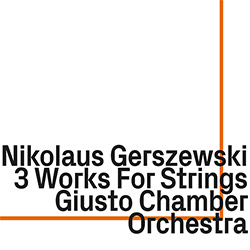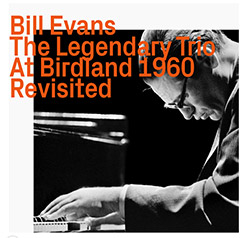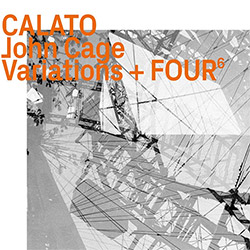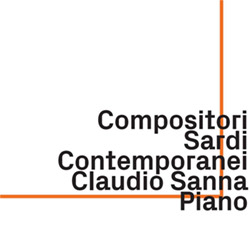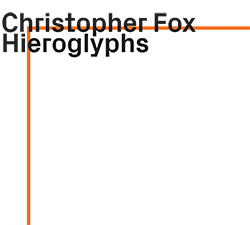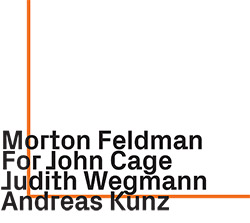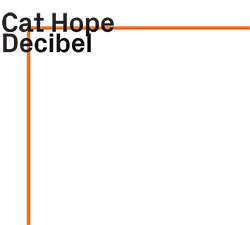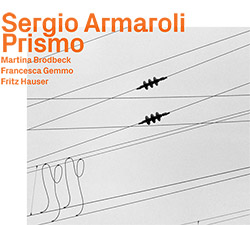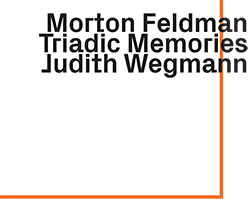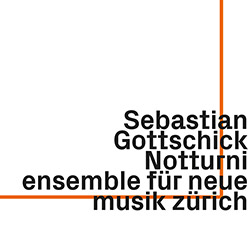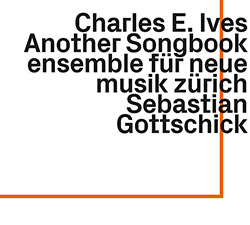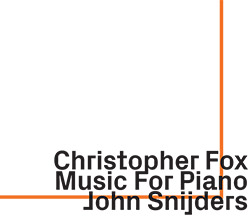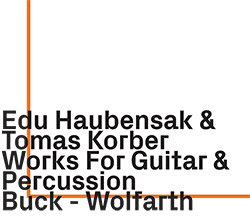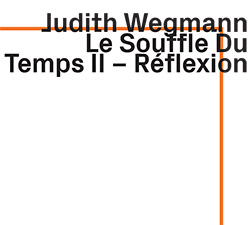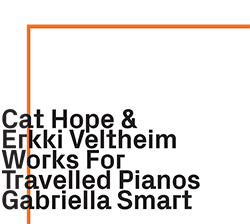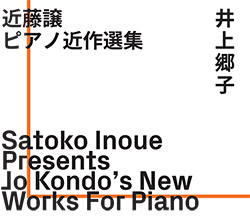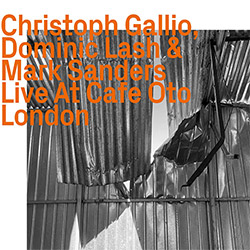![Inoue, Satoko / Jo Kondo: Presents Jo Kondo's Works for Piano, 2015-2020 <i>[Used Item]</i> (ezz-thetics by Hat Hut Records Ltd) Inoue, Satoko / Jo Kondo: Presents Jo Kondo's Works for Piano, 2015-2020 <i>[Used Item]</i> (ezz-thetics by Hat Hut Records Ltd)](https://www.teuthida.com/productImages/misc4/34377.jpg)
The third album of piano works from Japanese composer Jo Kondo performed by pianist Satoko Inoue, known for her interpretations of Morton Feldman, John Cage, Luc Ferrari, &c., here performing Kondo works written between 2013 and 2020 that apply different methods and approaches to form and interpretation, including works that incorporate improvisation and choices left to the performer.
In Stock
Quantity in Basket: None
Log In to use our Wish List
Shipping Weight: 2.00 units
Sample The Album:
Satoko Inoue-piano
Jo Kondo-piano, composer
Click an artist name above to see in-stock items for that artist.
UPC: 752156104629
Label: ezz-thetics by Hat Hut Records Ltd
Catalog ID: ezz-thetics 1046
Squidco Product Code: 34652
Format: CD
Condition: VG
Released: 2024
Country: Switzerland
Packaging: Cardboard Gatefold
Tracks 1 to 7 recorded at WDR Funkhouse, in Cologne, Germany, on April 25th and 26th, 2022, by Dirk Franken.
Track 8 recorded at the Main Hall Cultural Center of Fujimi City, Japan, on July 5th, 20222, by Yukio Kojima.
This is a USED (previously owned) item
"This CD, the third album of my piano works played by Satoko Inoue, presents all the pieces written for piano between 2015 and 2020, along with an introductory miniature piece from 2013.
A Contemplation (2013)
This tiny piece was a gift to my German friend composer Hauke Harder for his 50th birthday, whose work is characterized by contemplative calmness and the sonorities and temperament of just intonation. This piece consists of the repetition of a single chordal unit above the unchanging drone of C, each repetition is a minor third higher than the previous phrase so that the last repetition reaches an octave higher than the original. This entire process can be repeated as many times as the pianist wishes (in this recording, three times).
A Straw Hat Dance [version for piano] (2017/2020)
A Straw Hat Dance was originally written for harp solo towards the end of the summer (the season for the straw hat) of 2017. This piano version contains all the notes in the original version as they are, but with some additional articulation marks.
I have written several pieces with dance-like rhythmic character. This work, as the title implies, also shares that quality.
Caccia soave (2016)
Caccia soave is a piano version of Caccia for toy piano that I wrote in the same year. 'Caccia' is the Italian word for 'chase' or 'hunt' and is used traditionally as a musical term for a canon of folkloristic nature. My Caccia is, as the title implies, a two-voiced canon in unison, the first voice is imitated strictly by the second that lags behind, 'chasing' the leader. However, in this piece the canonic structure remains almost imperceptible to the listener's ear, because the two voices, sounding in the same register, intermingle with each other constantly, so that they become aurally inseparable. The intermingled voices create composite rhythmo-melodic patterns, different from the melodies in either voice. It is the kaleidoscopic succession of these ever-changing composite patterns (in other words, surface structures) that draws the listener's attention.
In Caccia soave, although all the notes in the original Caccia remain unchanged, they are transposed down, and re-phrased. Besides this, the tempo is made a little slower, and an 'echo' effect created by the reverberations from piano strings that are kept open (undamped) by the sostenuto-pedal is added. Through these adjustments, this piece may sound 'softer' than the original (hence, the adjective 'soave').
In Autumn [version for piano] (2014/2019)
In Autumn is also a piano version of a work originally written for a different medium, this time for koto and jushichigen (seventeen-stringed koto), in autumn of 2014.
Written in two voices, this piece is essentially nothing but a single, rhythmically flexible melodic line that runs from the beginning to the end. Each note constituting the line is accompanied by a 'shadow' tone (the second voice), generally in rhythmic unison with the main note (the first voice) but lagging behind slightly toward the end of the piece. This line with its shadow is interrupted here and there by one or two dyads played very softly, as if the background layer ('shadow') of the music is being exposed to the ears by the silence that shatters the continuity of the main line ('surface layer'). This double contrast-the combination of the contrasts between main and shadow tones on the one hand and the surface and shadow layers on the other - reveals great complexities concealed within the apparently artless single melodic line.
The listener may take it that the higher voice presents the 'main' notes and lower voice their shadows, or vice versa. Similarly, the louder parts may be heard as the 'surface layer' and the softer parts as the 'shadow layer', or vice versa. Things that stand out are sometimes nothing but shadows of the things behind them.
Interlude (2017)
The title 'interlude' suggests that the music I write (indeed any of my compositions), even if sounding as an autonomous, self-sufficient, independent entity, stands in-between two eternities, the past and the future: the things that have gone, and the things that will come.
Pomegranate (2020)
The form of this work is based on the responsorial plain chant, in which a cantor sings first and then the chorus responds. That is to say, a single melody is played, and then the melody is repeated along with other notes (in other words, with added thickness of sound). This repetition occurs twice (unlike in the case of responsorial chant), and the second repetition is with an even denser texture than the first. However, we cannot necessarily recognize that they are repetitions of the same melody because the original melodic line is buried in the chordal textures (i.e., the chord-colorings to each individual note that constitutes the original melody) which grow thicker with each repetition. Thus, the second repetition may be heard as a transformation of the melody into thicker sound aggregates.
In any case, after a melody is repeated a total of three times in this way, it is followed by a new melody. The entire form of the piece is based on the repetition of this process of three repetitions of each melody.
There is no particular reason why I named this piece 'pomegranate'. When I finished writing the piece, the name simply came up into my mind - that is the sole reason. Some time after I sent the completed score to Satoko Inoue, whom the piece was written for, I happened to learn that pomegranate is one of her favorite foods.
That said, you may imagine that there might have been some unconscious connection. But, of course, it's only a delusion.
Three Winter Months (2019)
Since the early 1970's, I have been composing music based on a single melodic line. Three Winter Months is not an exception, although it may not sound so to the listener's ears, due to the nature of the melodic line that spreads out over a very wide range. The continuity of the melodic line is made ambiguous intentionally in this piece. After the first 'phrase' of the melodic line is sung, the first and second halves of the phrase are played again but somehow combined simultaneously (in other words, the phrase is 'folded'). Then, the second phase is treated in the same way, followed by the third, and so on. In the 'folded' section of each 'phrase' repetition, the continuity of the melodic line becomes even more vague. What I am interested in when writing the piece is the threshold of perception, at what point scattered notes become a line (or melody), and at what point a melody transforms into 'sound texture' without melodic legitimacy in our aural perception. It took me three winter months to write the piece.
Helleborus, for piano four hands (2015)
My composition is a kind of improvisation. I start writing without any plan about the piece. I simply wait until the first note (or chord) visits me. Upon having it, I try to listen out to find what the next following note that the first one suggests, then the second note to the third, and so on. It is an improvisation not directly on the instrument but on paper, a very slow, time-consuming process of writing, conducted by contemplation on the sound that came to me. Helleborus is my winter contemplation. When the work had grown up to its final shape, the hellebore flowers in my yard were shivering quietly with the cold breeze of early spring."-Jo Kondo
Satoko Inoue
is a renowned leading interpreter of contemporary solo piano music. She finished the master's course of composition at the Tokyo Gakugei University. Since 1991, after her career as the member of "Musica Practica Ensemble", she has been engaged in solo activities. Her repertoires mainly include the works of Jo Kondo, Morton Feldman, John Cage and Luc Ferrari as well as those of other Japanese composers. Her activities have been worldwide, as she has played at international contemporary music festivals; given solo recitals in Europe, North and South America, and the Middle East; and made lectures for master classes of universities.
She was Professor at the Kunitachi College of Music in Tokyo until March 2023.
Artist Biographies
• Show Bio for Satoko Inoue "Satoko Inoue (井上 郷子 Inoue Satoko, January 29, 1958- ) is a Japanese musician. Inoue is a concert pianist whose performance repertoire is mainly contemporary music. Inoue is also Associate Professor at the Kunitachi College of Music in Tokyo. Inoue was born in Kobe, Japan. She entered the composition department of Tokyo Gakugei University, and graduated in 1981. She matriculated from the graduate department of the same university, where she studied composition and electronic music. Her masters' thesis was The composition study of John Cage's early piano pieces. She was the last student under Shesshu Kai, the late composer who had a big impact on her and she also studied piano under Atsuko Okada, a professor at the Tokyo College of Music. She played new pieces by young composers of her same generation at the concerts when she was a Graduate School student, then appeared at the concerts of the Japan Society for Contemporary Music and the Japan Federation of Composers. In 1986, Inoue became Pianist for the Musica Practica Ensemble organized by composer Jo Kondo. In 1991, she started her annual concert, Satoko Plays Japan, in Tokyo. She played 64 pieces composed by 28 composers including Jo Kondo, Toshi Ichiyanagi, Yori-aki Matsudaira and others she commissioned until 10th concert in 2000. From 2001, she included pieces by foreign countries' composers. She played 82 pieces in the series of concerts from 2001 to 2012 except in 2004 when she was too ill to play. She has commissioned 18 pieces by 12 composers, including Jo Kondo, Yuji Ito, Takashi Fujii, Haruyuki Suzuki, Doina Rotaru and others. The special programs of these concerts were Jo Kondo' works (1996, 1999 and 2011), Mieko Shiomi's works (2000) and [For Luc Ferrari ] concert title in 2007, Morton Feldman's works (2010) and Jon Cage's works in his second period (2012). In 2011, she had her two recitals " Satoko Plays Japan - the locus of 20 years - " entitled in which "collect commissioned works" and "Jo Kondo's works 1990-2011"as the 20th recital commemoration. Besides these concerts, she gives her recitals with themes at Kawai Music Shop Aoyama (Kawai Omote-sando) a few times a year. She gave solo recitals of works of Henry Cowell, Giacinto Scelsi, John Cage and others with very themes, had duet concerts with violinist Shiho Tejima and clarinetist Guido Arbonelli. In 1995-1999, Satoko organized her concerts with composer Yuji Ito at the Rene Kodaira, and played at that concerts total of 12 times. In 1999-2005, she gave recitals sponsored by the Japan Foundation In 2006, she had a solo recital with works by contemporary Japanese and American composers in New York City, and obtained high evaluation by "New York Concert Review /Winter2007" . From 2008, organizing and performance at the concerts series entitled "music documents" at Mon-naka tenjoh Hall in Tokyo, 3 times per year. In 2010, she was awarded "Keizo Saji Prize" by The Suntory Foundation for Arts with "Satoko Inoue Piano Recital #19 Morton Feldman-Works for Piano". 1983 - Bourges International Festival of Experimental Music In 2006 Solo recitals at the Turkish-Japanese Foundation Culture Center in Ankara under Turkey Embassy of Japan and Minar Sinan Guzel Sanatlar Universitesi Devlet Konservatuvari Oditorium in Istanbul. In 2011, the solo recital in Bern sponsored by Japanese Embassy in Switzerland, and performed at the musica aperta in Switzerland. Premiered the work of Akemi Naito (music) + Kristine Marx (imagery) at the Sarah Lawrence College in New York. Released solo performance CDs from HatHut,Switzerland and Edition Hundertmark, Germany. She has a lot of contemporary music repertoires including Jo Kondo, Toru Takemitsu, Yoritune Matsudaira, John Cage, Morton Feldman, Luciano Berio, Luc Ferrari and others." ^ Hide Bio for Satoko Inoue • Show Bio for Jo Kondo "Jo Kondo, Composer Born in Tokyo in 1947, Jo Kondo graduated from the composition department of Tokyo University of Arts in 1972. He spent a year studying in New York on a scholarship from the John D. Rockefeller III Fund in 1977-78. In 1979, he taught as guest lecturer at the University of Victoria, British Columbia, invited by the Canada Council, and in 1986 resided in London as a British Council Senior Fellow. In 1987, he was a composer in residence at Harrt School of Music, Hartford, Connecticut, USA and in 1987 and 2000 he taught at Dartington International Summer School in England. He was a professor at Ochanomizu University in Tokyo and Elisabeth University of Music in Hiroshima for many years. At present, he is a professor at Showa University of Music, Kawasaki, Japan and professor emeritus at Ochanomizu University in Tokyo. In 1980 Kondo founded the Musica Practica Ensemble, a chamber orchestra devoted to contemporary music, and was the artistic director of the group until its disbandment in 1991. He has written more than 160 compositions, ranging from solo pieces to orchestral and electronic works, which have been widely performed in Japan, North America, and Europe. These were recorded on Hat Art, Wergo, ALM, Fontec, Deutsche Grammophon, and other labels. He has received commissions from numerous organizations, ensembles and musicians. His music has been featured at many international music festivals such as the Huddersfield Contemporary Music Festival and Maggio Musicale Fiorentino. Performers associated with his music include the conductor Paul Zukofsky, Oliver Knussen, the pianist Satoko Inoue, the Ives and Nieuw Ensembles in the Netherlands, the London Sinfonietta, Birmingham Contemporary Music Group in the UK, and many others. Kondo has written extensively on musical matters and since 1979 he has published many books explaining in detail his own aesthetic and compositional ideas. He is also an associate editor of the Contemporary Music Review. He was on the jury of the Gaudeamus International Composer's competition, the Music Competition of Japan, and the Akutagawa Award for young Japanese composers, the Kyoto Prize and so on. He received the Odaka Prize (the best Japanese orchestra work in the year for his orchestra piece "In the Woods" in 1991, and the Nakajima Kenzo Prize for his achievements in the Japanese contemporary music in 2005. Jo Kondo was elected as an honorary member of the American Academy of Arts and Letters in 2012. In 2018, Jo Kondo was awarded "the 68th Minister of Education, Culture, Sports, Science and Technology's Art Encouragement Prize". The Chairman of Japan Society for Contemporary Music (The International Society for Contemporary Music - Japanese Section." ^ Hide Bio for Jo Kondo
1992 - Darmstadt Summer Contemporary Music Seminar
1993 - 5th Akiyoshidai International Contemporary Music Seminar & Festival
1999 - Performances at the department Muenster of the conservatory of music Detmold in Germany and Lille the Third University in France under the Nomura Cultural Foundation.
2001 - ISCM World Music Days 2001 in Yokohama-JSCM New Century Music Festival
2006 - 2nd ISCM-Romanian Section International Festival
2010 - The 9th Mersin International Music Festival in Turkey
2011 - Festival "l'Art pour l'Aar" in Switzerland)
3/29/2024
Have a better biography or biography source? Please Contact Us so that we can update this biography.
3/29/2024
Have a better biography or biography source? Please Contact Us so that we can update this biography.
Track Listing:
1. A Contemplation 3:35
2. A Straw Hat Dance 4:31
3. Caccia Soave 4:58
4. In Autumn 9:28
5. Interlude 7:01
6. Pomegranate 12:14
7. Three Winter Months 7:48
8. Helleborus, for piano four hands 7:18
Used CDs
Hat Art
Compositional Forms
Improvised Music
Piano & Keyboards
Solo Artist Recordings
New in Compositional Music
Recent Releases and Best Sellers
Used CD Alphabetic List
Search for other titles on the label:
ezz-thetics by Hat Hut Records Ltd.


![Inoue, Satoko / Jo Kondo: Presents Jo Kondo's Works for Piano, 2015-2020 <i>[Used Item]</i> (ezz-thetics by Hat Hut Records Ltd) Inoue, Satoko / Jo Kondo: Presents Jo Kondo's Works for Piano, 2015-2020 <i>[Used Item]</i> (ezz-thetics by Hat Hut Records Ltd)](https://www.teuthida.com/productImages/full/34652.Full.jpg)
